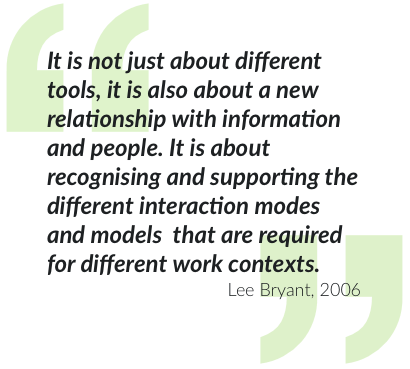Collaboration
Digital Workplace Futures
The digital workplace is not just about sharing and conversation, but also direct collaboration in pursuit of work goals. As collaborative behaviours mature and become the default for getting things done, teams can achieve very high-level of productivity through real-time working.
The key change over time has been a shift from collaboration as optional add-on to becoming embedded in the flow of work.
From a tools point of view, the rapid growth of Slack has changed the game in favour of real-time collaboration and ‘chat ops’ – the integration of multiple apps and data flows into a chat platform, and now Microsoft is picking up the pace by using Teams as its principal integration point.
In future, we expect people to be able to move seamlessly between tools and speeds/modes of collaboration.
> Introduction
> Technology
> Ownership
> Community
> Design
> Collaboration
> Skills
> Change Agents
> Leadership
> Org Structure
> Measurement
> Conclusion
- SHIFT 1: Communicate & Discuss
- SHIFT 2: Share & Discover
- SHIFT 3: Embedded In Workflow
- NEXT: Seamless Collaboration Experiences
- SHIFT 1: Communicate & Discuss
In early systems, all communication and collaboration activity was conducted on top of day-to-day work. Any form of social communication and discussion placed an extra burden on teams. This on-top-of-the-flow-of-work interaction caught on most easily in teams who already understood the power of collaboration. For example, IT teams who were aware of the value of the open-source community.
For the first time, employees were given explicit permission to have a voice and the tools to share it. This increased engagement and trust amongst employees, by giving them insight into the strategic agenda in a more authentic, less corporate way. Risk teams were also surprised to learn that undesirable online behaviour was negligible, and largely self-moderated.
However, these early tools were not scalable, so this form of collaboration had a limited impact on the wider organisation. Additionally, when trying to convert sceptical senior leaders, the extra burden did not produce sufficient visible value to make the changes a high priority.
A2. In 2011, I helped launch a discussion forum. V basic, but the 1st time employees were able and permitted, to talk to each other unmoderated. HUGE success with massive ripple effects culturally. I quickly got to work on the biz case for a true ESN install! (1/1) ^LJ #PS_Salon
— Postshift (@Postshift) April 5, 2019
A4 #PS_Salon – Real work use cases meeting enough space to experiment & learn 💪🏼
The #DigitalWorkplace needs to provide a significant value add in everyday work situations with a low entry barrier to create new routines and un-learn inefficient behaviors like e-mail ping-pong
— Lukas Fütterer // @lukizzl@mastodontech.de (@lukizzl) April 5, 2019
- SHIFT 2: Share & Discover
As internal communication teams learned about the value of these new systems of engagement, they began using them to share corporate news and generate a communications structure that mirrored the hierarchy of the organisation. This had a positive effect on the frequency of use as they became somewhere to discover and share key news. However, the phenomenon referred to as Conway’s Law (organisations which design systems … are constrained to produce designs which are copies of the structures of these organisations) meaning that the resulting designs were hierarchical & bureaucratic, slowing down communications across the organisation.
At the team level, collaboration was still document-centric with only limited ability to add comments at the file level, not in the flow of core information. Even discussion forums tended to hold discussion around documents rather than organic collaboration.
This meant tools were still primarily an additional overhead on individuals – another system to check and interact with. This was most problematic for frontline staff, who were rarely at a desk to check on news, and so needed more mobile experiences tailored directly to them.
- SHIFT 3: Embedded In Workflow
Individual teams are starting to embed the digital workplace directly into their processes and services, so that collaboration is simply an output of getting work done. This has become possible as the ‘platform + apps’ approach to the prevailing technology enables teams to easily use a variety of tools to get different types of collaborative work done, whilst easy integrations allow them to view a single stream of notifications, messages & work outputs.
The most essential part of the tool-set to emerge is a real-time, team-level collaboration tool (commonly MS Teams or Slack). These tools allow teams to pull together work from lots of systems and wrap it in conversation – finally bringing collaboration into the flow of work. Empowering digitally-savvy teams to design their own experiences allows them to simplify workflows and share more openly without the technology getting in the way. This promotes (at last) the true breaking down of information silos across traditional organisational boundaries.
Q4: it's all about the integrations + we have to mandate leaders to work in the DW in the open (mandate, not ask them pat them on the back for one post!). We need exemplars, but we also need to set the digital bar higher and avoid the idea this is a voluntary add-on #PS_Salon
— Lee Bryant (@leebryant) April 5, 2019
- NEXT: Seamless Collaboration Experiences
By simply defining what type of collaboration is suited to which tools, organisations will be able to enable their employees to work confidently regardless of where their collaborative experience starts. By removing focus on which tools to use, teams can focus on how they work together.
As new, emerging technologies are integrated into the digital workplace, new types of interactions will come to the fore. As we increasingly automate our day-to-day tasks, bots will join our teams as active participants in work. As augmented reality becomes widely available, enhanced, multi-location collaborative experiences will become richer. The possibilities for new modes of collaboration is endless, but businesses that get the most value will continue to focus on the human factors and evolutionary change.

